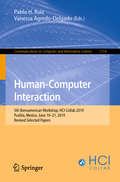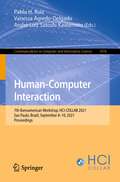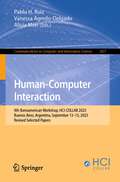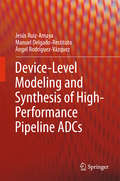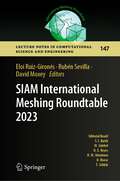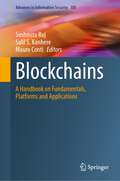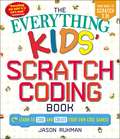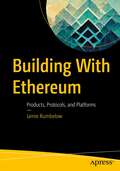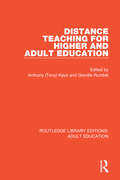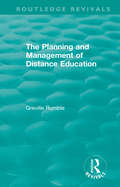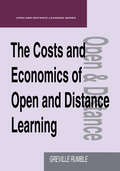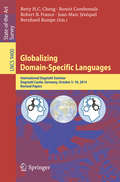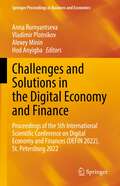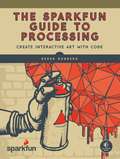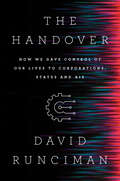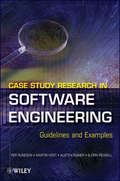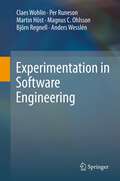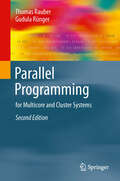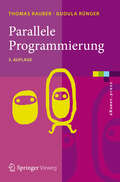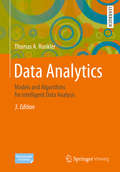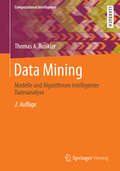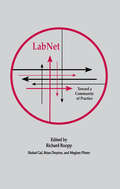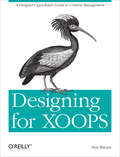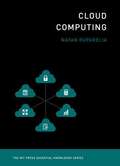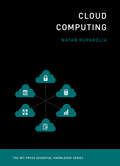- Table View
- List View
Human-Computer Interaction: 5th Iberoamerican Workshop, HCI-Collab 2019, Puebla, Mexico, June 19–21, 2019, Revised Selected Papers (Communications in Computer and Information Science #1114)
by Pablo H. Ruiz Vanessa Agredo-DelgadoThis book constitutes the proceedings of the 5th Iberoamerican Workshop on Human-Computer Interaction, HCI-Collab 2019, held in Puebla, Mexico, in June 2019.The 31 full papers presented in this volume were carefully reviewed and selected from 55 submissions. The papers describe models, design patterns, implementations, evaluations of existing applications, and systemic reviews; all of which are very important aspects within HCI.
Human-Computer Interaction: 7th Iberoamerican Workshop, HCI-COLLAB 2021, Sao Paulo, Brazil, September 8–10, 2021, Proceedings (Communications in Computer and Information Science #1478)
by Pablo H. Ruiz Vanessa Agredo-Delgado André Luiz Satoshi KawamotoThis book constitutes the thoroughly refereed proceedings of the 7th Iberoamerican Workshop on Human-Computer Interaction, HCI-Collab 2021, held in Sao Paulo, Brazil, in September 2021.*The 15 full and 4 short papers presented in this volume were carefully reviewed and selected from 68 submissions. The papers deal with topics such as emotional interfaces, usability, video games, computational thinking, collaborative systems, IoT, software engineering, ICT in education, augmented and mixed virtual reality for education, gamification, emotional Interfaces, adaptive instruction systems, accessibility, use of video games in education, artificial Intelligence in HCI, among others.*The workshop was held virtually due to the COVID-19 pandemic.
Human-Computer Interaction: 9th Iberoamerican Workshop, HCI-COLLAB 2023, Buenos Aires, Argentina, September 13–15, 2023, Revised Selected Papers (Communications in Computer and Information Science #1877)
by Pablo H. Ruiz Vanessa Agredo-Delgado Alicia MonThis book constitutes the referred proceedings of the 9th Iberoamerican Workshop on Human-Computer Interaction, HCI-COLLAB 2023, held in Buenos Aires, Argentina, during September 13–15, 2023. The 23 full papers presented in this book were carefully reviewed and selected from 84 submissions. They cover a variety of topics related to HCI such as: Emotional Interfaces, Usability, Video Games and Gamification, Computational Thinking, Internet of Things (IoT), Software Engineering, ICT in Education, Augmented and Mixed Virtual Reality for Education, Emotional Interfaces, Adaptive Instructional Systems, Accessibility, Artificial Intelligence in HCI, Industry 4. 0 and HCI, Infotainment Systems, Intelligent Systems, Collaborative Work and Learning, Cognition, and Interaction, among others.
Device-Level Modeling and Synthesis of High-Performance Pipeline ADCs
by Jesús Ruiz-Amaya Ángel Rodríguez-Vázquez Manuel Delgado-RestitutoThis book presents models and procedures to design pipeline analog-to-digital converters, compensating for device inaccuracies, so that high-performance specs can be met within short design cycles. These models are capable of capturing and predicting the behavior of pipeline data converters within less than half-a-bit deviation, versus transistor-level simulations. As a result, far fewer model iterations are required across the design cycle. Models described in this book accurately predict transient behaviors, which are key to the performance of discrete-time systems and hence to the performance of pipeline data converters.
SIAM International Meshing Roundtable 2023 (Lecture Notes in Computational Science and Engineering #147)
by Eloi Ruiz-Gironés Rubén Sevilla David MoxeyThis volume comprises selected papers from the SIAM International Meshing Roundtable Workshop 2023, SIAM IMR 2023, held in Amsterdam, the Netherlands, March 6-9, 2023. The IMR was started by Sandia National Laboratories in 1992 and, since 2021, it has been held under the umbrella of the Society for Industrial and Applied Mathematics (SIAM). The SIAM IMR 2023 was the first in-situ conference to be held since 2019, after two online conferences. It consisted of short courses, technical presentations from keynotes, contributed talks and research notes, a poster session and meshing contest, and discussion panels. The papers in these proceedings present novel contributions that range from theoretical advances to technical applications in engineering, geometric modeling, computer graphics, visualization, and machine learning.
Blockchains: A Handbook on Fundamentals, Platforms and Applications (Advances in Information Security #105)
by Sushmita Ruj Salil S. Kanhere Mauro ContiThis handbook is a selection of foundational aspects, security analysis, platforms, and applications of blockchains that consists of four parts. The first part introduces the basic building blocks such as distributed computing and cryptography. Consensus algorithms that form the basic backbone of blockchain protocols are presented. Various cryptographic tools like hash functions, digital signatures and commitment schemes are also introduced. Advanced cryptographic techniques such as zero knowledge protocols, secret sharing, verifiable random functions that are used for privacy-preserving and secure design are discussed. The second part of this handbook consists of popular blockchain designs and platforms. Architecture of Bitcoin, Ethereum, Monero, Tendermint and Algorand have been presented. Various important issues like scalability and security are discussed in the third part. Security design challenges, security vulnerabilities and their analysis are discussed. The final part of this handbook discusses various applications of blockchains. These include supply-chain, identity and credential management, Internet of Things (IoT), data-sharing, e-voting, e-governance, e-health, smart cities, and Industry 4.0. Research challenges and directions of future work are included in this handbook.This comprehensive reference targets students and researchers, who are starting to explore blockchain. Professionals working in blockchain security and applications will find this handbook to be a valuable reference.
The Everything Kids' Scratch Coding Book: Learn to Code and Create Your Own Cool Games! (Everything® Kids)
by Jason RukmanTeach kids the concepts of coding in easy-to-understand language and help them develop games of their own with The Everything Kids’ Scratch Coding Book!Understanding computer science is becoming a necessity in the modern age. As our world shifts towards becoming increasingly more technical and automated, the ability to code and understand computers has become one of the most valuable skills any child can have on the road to a successful life. More and more schools are recognizing this importance and have started to implement computer science and coding as core elements in their curriculums, right alongside math and history. The Everything Kids’ Scratch Coding Book helps children get a head start on this new essential skill, with Scratch coding—a language designed by MIT specifically to help a younger audience learn to code. In no time, children will learn basic coding concepts, build fun games, and get a competitive edge on their classmates. This book encourages children to think analytically and problem-solve, while helping them develop an essential skill that will last them a lifetime.
Building With Ethereum: Products, Protocols, and Platforms
by Jamie RumbelowBuild products on top of Ethereum's new and expansive technological stack. Writing any good web application requires planning, care, and deft technical skills, but Ethereum's execution model presents its own challenges for engineers wishing to build applications on top of its smart contract layer. Building performant and engaging product experiences is one of the most important – and often underappreciated – roles in any company. This book looks at the full product stack needed to build such experiences on top of Ethereum smart contracts, weaving tutorials and case studies through more conversational discussions of the various constraints, trade-offs, and complexities involved in doing so. You’ll learn about the fundamentals of Ethereum from a new perspective, developing a strong understanding of how the Ethereum Virtual Machine (EVM) works and how it affects product engineering, as well as all the pieces of technology that go into decentralized apps (dapps) behind the front end: RPC nodes, wallets, indexers, application hosts, and more. You’ll be exposed to plenty of UI, JavaScript code, and idiomatic ways to bring on-chain data into your front ends. And you’ll be given up-to-date knowledge of the best practices and future possibilities that decentralized computation might offer the product engineer.What You Will LearnUnderstand the EVM and how it worksGain insight into smart contracts and how apps connect to themUnderstand the difference between live data and indexed dataHow decentralization affects the UI of applicationsBuild engaging, tasteful product experiences on top of EthereumWho This Book Is ForA confident – mid-level or senior – software engineer or web developer who hasn’t properly branched out into Ethereum; someone who might have scratched the surface, but wants a deeper understanding of the principles behind dapps, and who wants a head start on the hurdles faced while building them.
Distance Teaching For Higher and Adult Education (Routledge Library Editions: Adult Education)
by Anthony Tony Kaye And Greville RumbleOriginally published in 1981 this volume provides a detailed analysis of the factors - strategic, pedagogic, operational, organisational and financial -which should be taken into account in the planning and running of large-scale, centralised distance education systems at the higher education level. The book uses evidence drawn from Open University type institutions in Canada, Costa Rica, Germany, Iran, Israel, Pakistan, Spain, Sri Lanka, Venezuela and the UK.
The Planning and Management of Distance Education (Routledge Revivals)
by Greville RumbleOriginally published in 1986, The Planning and Management of Distance Education examines the problems faced by those who are setting up and managing distance education systems of various kinds. The book begins by considering definitions of distance education and various models which can be used to describe and understand distance education systems. The second chapter considers various general education models and relates these to distance education. The concepts introduced in the first two chapters form a background to the rest of the book. The next section looks at the aspirations of those setting up distance education systems, the economics and costs of such systems, and the process of planning a distance education system from scratch (chapters 3-5). Chapters 6-11 consider aspects of planning and management – organisation, staffing, planning, budgeting, the management of the academic processes related to materials development and the provision of local student services, production management (the management of materials production and distribution), operations management (the management of the delivery of student services) – and the impact of new technology on production and operations management, and finally, evaluation. The short concluding chapter draws together some of the themes running through the book.
The Costs and Economics of Open and Distance Learning (Open And Distance Learning Ser.)
by Rumble, Greville (Lecturer, Open University)Dissecting in detail the arguments underlying the costs and economics of open and distance learning, this text should give the reader an insight and the confidence to cost their own open and distance learning projects.
Globalizing Domain-Specific Languages
by Bernhard Rumpe Jean-Marc Jézéquel Robert B. France Benoit Combemale Betty H. C. ChengThe development of modern complex software-intensive systems often involves the use of multiple DSMLs that capture different system aspects. Supporting coordinated use of DSMLs leads to what we call the globalization of modeling languages, that is, the use of multiple modeling languages to support coordinated development of diverse aspects of a system. In this book, a number of articles describe the vision and the way globalized DSMLs currently assist integrated DSML support teams working on systems that span many domains and concerns to determine how their work on a particular aspect influences work on other aspects. Globalized DSMLs offer support for communicating relevant information, and for coordinating development activities and associated technologies within and across teams, in addition to providing support for imposing control over development artifacts produced by multiple teams. DSMLs can be used to support socio-technical coordination by providing the means for stakeholders to bridge the gap between how they perceive a problem and its solution, and the programming technologies used to implement a solution. They also support coordination of work across multiple teams. DSMLs developed in an independent manner to meet the specific needs of domain experts have an associated framework that regulates interactions needed to support collaboration and work coordination across different system domains. The articles in the book describe how multiple heterogeneous modeling languages (or DSMLs) can be related to determine how different aspects of a system influence each other. The book includes a research roadmap that broadens the current DSML research focus beyond the development of independent DSMLs to one that provides support for globalized DSMLs.
Challenges and Solutions in the Digital Economy and Finance: Proceedings of the 5th International Scientific Conference on Digital Economy and Finances (DEFIN 2022), St.Petersburg 2022 (Springer Proceedings in Business and Economics)
by Anna Rumyantseva Vladimir Plotnikov Alexey Minin Hod AnyigbaThis volume presents the proceedings of the 4th International Scientific and Practical Conference on Digital Economy and Finances (DEFIN22) at the Saint-Petersburg University of Management Technologies and Economics (UMTE), which took place in March 2022. It includes the newest research on the impact of new digital technologies on the growth and capitalization of companies and the labor market. The volume discusses the problems of situational modeling of economic processes and the creation of "digital twins" of enterprises. The contributions analyse how big data and artificial intelligence technologies are shaping the financial markets.
The SparkFun Guide to Processing
by Derek RunbergProcessing is a free, beginner-friendly programming language designed to help non-programmers create interactive art with code.The SparkFun Guide to Processing, the first in the SparkFun Electronics series, will show you how to craft digital artwork and even combine that artwork with hardware so that it reacts to the world around you. Start with the basics of programming and animation as you draw colorful shapes and make them bounce around the screen. Then move on to a series of hands-on, step-by-step projects that will show you how to:–Make detailed pixel art and scale it to epic proportions–Write a maze game and build a MaKey MaKey controller with fruit buttons–Play, record, and sample audio to create your own soundboard–Fetch weather data from the Web and build a custom weather dashboard–Create visualizations that change based on sound, light, and temperature readingsWith a little imagination and Processing as your paintbrush, you’ll be on your way to coding your own gallery of digital art in no time! Put on your artist’s hat, and begin your DIY journey by learning some basic programming and making your first masterpiece with The SparkFun Guide to Processing.The code in this book is compatible with Processing 2 and Processing 3.
The Handover: How We Gave Control of Our Lives to Corporations, States and AIs
by David RuncimanAn eminent political thinker uses our history with states and corporations—“artificial agents” to which we have granted immense power—to predict how AI will remake society. Countless books, news reports, and opinion pieces have announced the impending arrival of artificial intelligence, with most claiming that it will upend our world, revolutionizing not just work but society overall. Yet according to political philosopher and historian David Runciman, we’ve actually been living with a version of AI for 300 years?because states and corporations are robots, too. In The Handover, Runciman explains our current situation through the history of these “artificial agents” we created to rescue us from our all-too-human limitations—and demonstrates what this radical new view of our recent past means for our collective future. From the United States and the United Kingdom to the East India Company, Standard Oil, Facebook, and Alibaba, states and corporations have gradually, and then much more rapidly, taken over the planet. They have helped to conquer poverty and eliminate disease, but also unleashed global wars and environmental degradation. As Runciman demonstrates, states and corporations are the ultimate decision-making machines, defined by their ability to make their own choices and, crucially, to sustain the consequences of what has been chosen. And if the rapid spread of the modern state and corporation has already transformed the conditions of human existence, new AI technology promises the same. But what happens when AI interacts with other kinds of artificial agents, the inhuman kind represented by states and corporations? Runciman argues that the twenty-first century will be defined by increasingly intense battles between state and corporate power for the fruits of the AI revolution. In the end, it is not our own, human relationship with AI that will determine our future. Rather, humanity’s fate will be shaped by the interactions among states, corporations, and thinking machines. With clarity and verve, The Handover presents a brilliantly original history of the last three centuries and a new understanding of the immense challenges we now face.
Case Study Research in Software Engineering
by Per Runeson Martin Höst Austen Rainer Björn RegnellBased on their own experiences of in-depth case studies of software projects in international corporations, in this book the authors present detailed practical guidelines on the preparation, conduct, design and reporting of case studies of software engineering. This is the first software engineering specific book on the case study research method.
Experimentation in Software Engineering
by Per Runeson Anders Wesslén Claes Wohlin Björn Regnell Magnus C. Ohlsson Martin HöstLike other sciences and engineering disciplines, software engineering requires a cycle of model building, experimentation, and learning. Experiments are valuable tools for all software engineers who are involved in evaluating and choosing between different methods, techniques, languages and tools. The purpose of Experimentation in Software Engineering is to introduce students, teachers, researchers, and practitioners to empirical studies in software engineering, using controlled experiments. The introduction to experimentation is provided through a process perspective, and the focus is on the steps that we have to go through to perform an experiment. The book is divided into three parts. The first part provides a background of theories and methods used in experimentation. Part II then devotes one chapter to each of the five experiment steps: scoping, planning, execution, analysis, and result presentation. Part III completes the presentation with two examples. Assignments and statistical material are provided in appendixes. Overall the book provides indispensable information regarding empirical studies in particular for experiments, but also for case studies, systematic literature reviews, and surveys. It is a revision of the authors' book, which was published in 2000. In addition, substantial new material, e.g. concerning systematic literature reviews and case study research, is introduced. The book is self-contained and it is suitable as a course book in undergraduate or graduate studies where the need for empirical studies in software engineering is stressed. Exercises and assignments are included to combine the more theoretical material with practical aspects. Researchers will also benefit from the book, learning more about how to conduct empirical studies, and likewise practitioners may use it as a "cookbook" when evaluating new methods or techniques before implementing them in their organization.
Parallel Programming: for Multicore and Cluster Systems
by Gudula Rünger Thomas RauberInnovations in hardware architecture, like hyper-threading or multicore processors, mean that parallel computing resources are available for inexpensive desktop computers. In only a few years, many standard software products will be based on concepts of parallel programming implemented on such hardware, and the range of applications will be much broader than that of scientific computing, up to now the main application area for parallel computing. Rauber and Rünger take up these recent developments in processor architecture by giving detailed descriptions of parallel programming techniques that are necessary for developing efficient programs for multicore processors as well as for parallel cluster systems and supercomputers. Their book is structured in three main parts, covering all areas of parallel computing: the architecture of parallel systems, parallel programming models and environments, and the implementation of efficient application algorithms. The emphasis lies on parallel programming techniques needed for different architectures. For this second edition, all chapters have been carefully revised. The chapter on architecture of parallel systems has been updated considerably, with a greater emphasis on the architecture of multicore systems and adding new material on the latest developments in computer architecture. Lastly, a completely new chapter on general-purpose GPUs and the corresponding programming techniques has been added. The main goal of the book is to present parallel programming techniques that can be used in many situations for a broad range of application areas and which enable the reader to develop correct and efficient parallel programs. Many examples and exercises are provided to show how to apply the techniques. The book can be used as both a textbook for students and a reference book for professionals. The material presented has been used for courses in parallel programming at different universities for many years.
Parallele Programmierung
by Gudula Rünger Thomas RauberMultiprozessor-Desktoprechner, Cluster von PCs und Innovationen wie Hyperthreading oder Multicore-Prozessoren machen parallele Rechenressourcen allgegenwärtig. Die Ausnutzung dieser Rechenleistung ist jedoch nur durch parallele Programmiertechniken möglich. Das Buch stellt diese Techniken für herkömmliche Parallelrechner und für neuartige Plattformen umfassend dar. Neben den Grundlagen der parallelen Programmierung werden Programmierumgebungen wie Pthreads, Java-Threads, OpenMP, MPI oder PVM sowie die zugehörigen Programmiermodelle behandelt.
Data Analytics: Models and Algorithms for Intelligent Data Analysis
by Thomas A. RunklerThis book is a comprehensive introduction to the methods and algorithms of modern data analytics. It provides a sound mathematical basis, discusses advantages and drawbacks of different approaches, and enables the reader to design and implement data analytics solutions for real-world applications. This book has been used for more than ten years in the Data Mining course at the Technical University of Munich. Much of the content is based on the results of industrial research and development projects at Siemens.
Data Mining: Modelle und Algorithmen intelligenter Datenanalyse (Computational Intelligence)
by Thomas A. RunklerDieses Lehrbuch behandelt die wichtigsten Methoden zur Erkennung und Extraktion von ,,Wissen" aus numerischen und nicht-numerischen Datenbanken in Technik und Wirtschaft. Der Autor vermittelt einen kompakten und zugleich fundierten #65533;berblick #65533;ber die verschiedenen Methoden sowie deren Zielsetzungen und Eigenschaften. Dadurch werden Leser bef#65533;higt, Data Mining eigenst#65533;ndig anzuwenden.
Labnet: Toward A Community of Practice (Technology and Education Series)
by Richard Ruopp Shahaf Gal Brian Drayton Meghan PfisterConnected by a computer telecommunications network, ninth-graders from eight high schools scattered thousands of miles across Alaska work together, building a robot submarine to gather samples from the floor of Prince William Sound. This is high school science as some teachers and educational reformers today envision it -- centered on student projects that encourage learning by doing...supported by modern technology...enriched by collaboration among students and teachers, both face to face and far apart. This example is drawn from LabNet, a three-year effort funded by the National Science Foundation. The project was conducted by Technical Education Research Centers (TERC), a nonprofit educational organization dedicated to improving mathematics and science education. Eventually reaching 562 teachers in 37 states, Puerto Rico, and American Samoa, LabNet had a direct impact on their classroom practice. In a follow-up evaluation, the majority said they had assigned their students more projects and had used LabNet's telecommunications network to exchange project ideas with other teachers. This book is the story of LabNet as told by its editors, with 14 additional essays on science projects -- both theoretical and practical -- by LabNet teachers and TERC staff.
Designing for XOOPS: A Designer's Quickstart Guide to Content Management
by Sun RuoyuLearn how to customize websites with XOOPS, the open source CMS that helps non-developers build dynamic community websites, intranets, and other applications. This concise book shows you how to use XOOPS themes and modules to design everything from simple blogs to large database-driven CMS portals. Web designers and current XOOPS users will learn how to create a site theme with CSS and jQuery libraries, including techniques for making additional modules conform to the site's look and feel. Although XOOPS uses the PHP-based Smarty templating system, all you need is a bit of XHTML and CSS experience to get started. Learn the workflow for turning an idea into a full-featured website Become familiar with XOOPS' theme-building tools, and set up PHP and MySQL environments Port an existing XHTML template to XOOPS Create themes with the 960 Grid System to save time and reduce code Use jQuery-based UI libraries to achieve complex effects Blend new modules into your theme with the template override function Go beyond traditional block layouts to customize your homepage
Cloud Computing
by Nayan B. RupareliaMost of the information available on cloud computing is either highly technical, with details that are irrelevant to non-technologists, or pure marketing hype, in which the cloud is simply a selling point. This book, however, explains the cloud from the user's viewpoint -- the business user's in particular. Nayan Ruparelia explains what the cloud is, when to use it (and when not to), how to select a cloud service, how to integrate it with other technologies, and what the best practices are for using cloud computing. Cutting through the hype, Ruparelia cites the simple and basic definition of cloud computing from the National Institute of Science and Technology: a model enabling ubiquitous, convenient, on-demand network access to a shared pool of configurable computing resources. Thus with cloud computing, businesses can harness information technology resources usually available only to large enterprises. And this, Ruparelia demonstrates, represents a paradigm shift for business. It will ease funding for startups, alter business plans, and allow big businesses greater agility. Ruparelia discusses the key issues for any organization considering cloud computing: service level agreements, business service delivery and consumption, finance, legal jurisdiction, security, and social responsibility. He introduces novel concepts made possible by cloud computing: cloud cells, or specialist clouds for specific uses; the personal cloud; the cloud of things; and cloud service exchanges. He examines use case patterns in terms of infrastructure and platform, software information, and business process; and he explains how to transition to a cloud service. Current and future users will find this book an indispensable guide to the cloud.
Cloud Computing (The MIT Press Essential Knowledge Series)
by Nayan B. RupareliaWhy cloud computing represents a paradigm shift for business, and how business users can best take advantage of cloud services. Most of the information available on cloud computing is either highly technical, with details that are irrelevant to non-technologists, or pure marketing hype, in which the cloud is simply a selling point. This book, however, explains the cloud from the user's viewpoint—the business user's in particular. Nayan Ruparelia explains what the cloud is, when to use it (and when not to), how to select a cloud service, how to integrate it with other technologies, and what the best practices are for using cloud computing. Cutting through the hype, Ruparelia cites the simple and basic definition of cloud computing from the National Institute of Science and Technology: a model enabling ubiquitous, convenient, on-demand network access to a shared pool of configurable computing resources. Thus with cloud computing, businesses can harness information technology resources usually available only to large enterprises. And this, Ruparelia demonstrates, represents a paradigm shift for business. It will ease funding for startups, alter business plans, and allow big businesses greater agility. Ruparelia discusses the key issues for any organization considering cloud computing: service level agreements, business service delivery and consumption, finance, legal jurisdiction, security, and social responsibility. He introduces novel concepts made possible by cloud computing: cloud cells, or specialist clouds for specific uses; the personal cloud; the cloud of things; and cloud service exchanges. He examines use case patterns in terms of infrastructure and platform, software information, and business process; and he explains how to transition to a cloud service. Current and future users will find this book an indispensable guide to the cloud.
